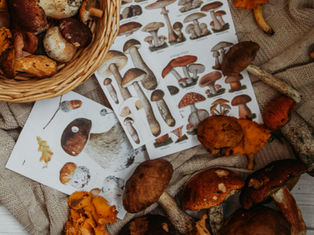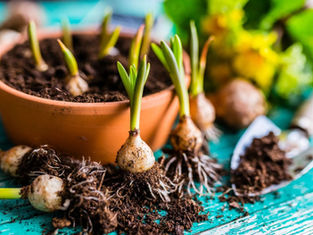September Garden Checklist: 9 Tasks to set up a thriving fall garden
- Grow-Mate Organic Gardening
- Aug 27
- 3 min read
As summer fades and the first cool breezes of fall arrive, September offers a unique opportunity to prep your garden for the season ahead. Whether you’re looking to extend your harvest, fortify your soil, or prepare for winter, now is the perfect time to make strategic moves. By following these 9 key tasks, you’ll not only set your garden up for a thriving fall but also build a strong foundation for next spring.
Here’s your September Garden Checklist to ensure your plants, soil, and tools are all ready for the change in seasons.


1. Clear Out Spent Plants
First things first: remove any summer crops that are past their prime. Pull out dead or diseased plants (these should go to the compost bin, not the garden). By clearing out spent plants, you’ll create more space for fall-friendly crops and keep potential pests or diseases at bay.
2. Refresh the Soil
After a long growing season, your soil is likely depleted of essential nutrients. Take the opportunity to work in compost, well-rotted manure, or organic amendments to restore vitality. For even better results, try adding RootMax — this powerful microbial product enhances root growth and soil health, making your plants stronger and more resilient as they head into the cooler months. A microbial soil drench, such as Tricho Protect, can also help control soil-borne pathogens and promote healthy root development.

3. Harvest Seeds from Early Summer-Flowering Perennials & Annuals
This is the perfect time to gather seeds from plants that bloomed earlier in the year. Save seeds from hardy annuals like marigolds, zinnias, and sunflowers, as well as perennials that are self-sowing or have good seed production. Store them in a cool, dry place for next season’s planting or even to share with fellow gardeners.
4. Plant Cool-Season Crops
Now is the time to plant cool-season vegetables that thrive in September’s mild temperatures. Spinach, lettuce, kale, and radishes are all great options for a quick harvest before frost. In addition, herbs like cilantro and parsley can be seeded directly into the garden for fresh fall flavour. To give these crops the best start, consider using GrowthMax to ensure your plants get the nutrients they need for strong growth and abundant harvests.

5. Add Mulch for Moisture & Protection
With temperatures fluctuating, a fresh layer of mulch can go a long way in preserving soil moisture during warm days and protecting roots from the coming cold. Use organic mulches such as straw, shredded leaves, or wood chips to keep your garden beds insulated and healthy.
6. Sow Cover Crops
Cover crops are a gardener’s best friend, especially during the fall. Planting winter rye, clover, or vetch can protect your soil from erosion, add organic matter, and naturally fix nitrogen for the next growing season. These crops will help improve your soil’s health, which will be incredibly beneficial when spring rolls around. Consider using RootMax with your cover crops to boost root development and increase microbial activity in the soil.
7. Start a Compost Heap
If you haven’t already, September is the perfect time to start a compost heap. With all the fall leaves, plant debris, and kitchen scraps, there’s no better time to start turning organic waste into nutrient-rich compost for your garden. This will help feed your soil for the next growing season and reduce waste. Make sure to layer green (e.g., kitchen scraps, grass clippings) and brown materials (e.g., leaves, straw) to keep the compost process balanced. Add GrowthMax to the compost pile to help speed up decomposition and enhance the nutrient value of your finished compost.
8. Prep Perennials for Winter
Cut back spent perennial foliage, divide crowded clumps, and mulch around the base of plants. This preparation will help perennials conserve energy and stay protected from freezing temperatures. Take this time to assess your plants’ health and remove any dead or weak growth.
9. Clean & Organise Your Tools
Finally, take the time to clean and sharpen your gardening tools. A well-maintained toolset will last longer and make your gardening tasks much easier. Be sure to oil metal parts to prevent rust, sharpen your pruners and shovels, and store everything properly for the upcoming seasons.

September is more than just the transition between summer and fall — it’s the perfect time to set your garden up for continued growth. By completing these tasks, you’ll create healthier soil, extend your harvest, and ensure your garden is prepared for winter. The hard work you put in now will pay off with a thriving, resilient garden come next spring.
👉 Want more gardening tips like these? Subscribe to the Growmate Newsletter for seasonal insights, expert advice, and product updates delivered right to your inbox.
Shop Now for Growmate Organic Gardening products






Great checklist! 🍂 This is exactly the time of year I start pulling out tired summer plants and working compost back into the beds. I’m planning to seed spinach and kale this week
👋Thanks for sharing this guide—it came at just the right time! I’ve already cleared out my summer plants and added compost to freshen up the soil. Next on my list is planting some cool-weather greens like spinach and lettuce, and I’m excited to try winter rye as a cover crop this year. Also love the reminder about cleaning and organizing tools—I always forget that part, but it really does make the season go smoother!🌱